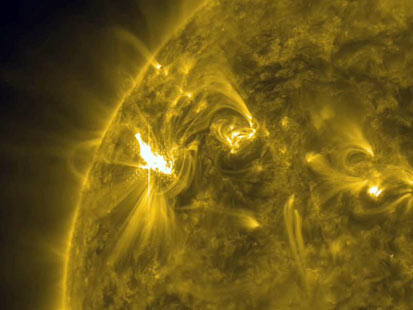Enormous Sunspot Could Lead to Solar Flares

A massive sunspot has the potential to create solar flares like these, directed toward Earth. NASA image.
The largest sunspot seen in years has appeared on the surface of the sun, and scientists say it could generate solar flares whose effects are visible on Earth.
The sunspot cluster - shaped a little like the islands of Hawaii - is much larger than Earth. It measures 100,000 miles from end to end, while the diameter of the Earth is approximately 7,900 miles.
We on the surface are happily shielded by Earth's magnetic field and atmosphere, but sensitive electronics have, on occasion, been fried by solar radiation.
"We are going toward the peak of the solar cycle right now," said Lead Scientist for NASA's Living With a Star Program, Madhulika Guhathakurta. "It typically goes through an 11-year cycle in which the magnetic field in the sun goes from minimum to maximum. Right now, we're rising toward the maximum and during that time, the number of sunspots increases."
The placement of the sunspot cluster could mean solar flares directed toward Earth, but NASA says not to worry.
"Everyone is watching the sunspot because it has the potential to produce strong flares, but that doesn't necessarily mean we're going to have a severe magnetic storm," Guhathakurta said.
"We can't predict anything ahead of time," Guhathakurta said. "We have to wait for particles to arrive at a certain point where we have a spacecraft, and this measures the particles and the orientation of the magnetic field - that's when we'll know if the particles will penetrate through."
NOAA and NASA would then issue a forecast alert to notify people of the possibility of disruptions.
If particles penetrate through, they do have the potential to affect satellites, interfere with radio signals and, in the most severe situations, create voltage fluctuations in power grids. A 1989 power blackout in Quebec was later blamed on a solar storm, though there's been nothing comparable since.
But, Guhathakurta said, "There's really nothing to be afraid of. It's typically only electronics and machinery that are affected."